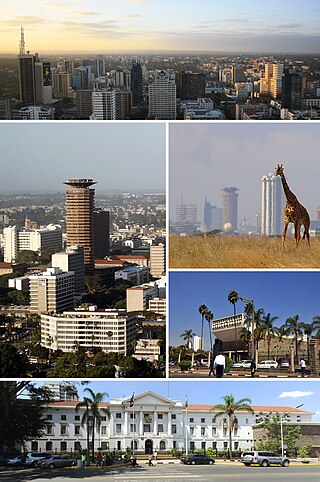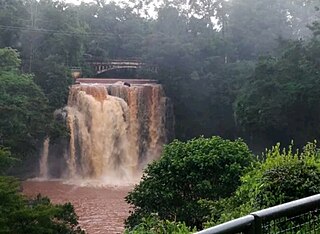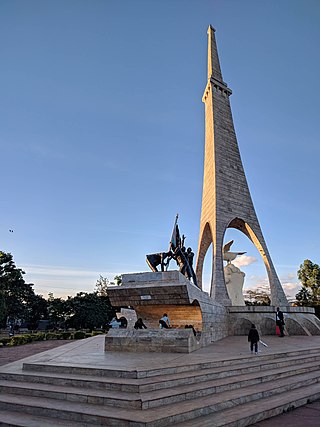Related Research Articles

Nairobi is the capital and largest city of Kenya. The name is derived from the Maasai phrase Enkare Nairobi, which translates to 'place of cool waters', a reference to the Nairobi River which flows through the city. The city proper had a population of 4,397,073 in the 2019 census. The city is commonly referred to as The Green City in the Sun.

Emilio Mwai Kibaki was a Kenyan politician who served as the third President of Kenya from December 2002 until April 2013.

The Kikuyu are a Bantu ethnic group native to East Africa Central Kenya. At a population of 8,148,668 as of 2019, they account for 17.13% of the total population of Kenya, making them Kenya's largest ethnic group.

Kitengela is a municipality in the Kajiado County of Kenya, located 34 Kilometres south of the capital Nairobi, forming part of the greater Metropolitan Area. Kitengela began as The Kitengela group ranch, made up of 18,292 ha and 214 registered members which was subdivided in 1988 in efforts by the Government to encourage private land ownership in pastoral systems, with the aim of intensifying and commercializing livestock production. After subdivision of the group ranch, land fragmentation and sales have continued at a steady and escalating pace. The human population within the Kitengela area has more than doubled in the last 10 years, from 6548 in 1989 to 17,347 in 1999 to 58,167 in 2009. There is also a town named Kitengela in the area.
Ngai is the monolithic Supreme God in the spirituality of the Kikuyu and the closely related Embu, Meru and Kamba groups of Kenya, and the Maasai of Kenya and Tanzania. Ngai is the creator of the universe and all in it. Regarded as the omnipotent God, the Kikuyu, Embu, Meru, Kamba and the Maasai of Kenya worshiped Ngai facing the Mt. Kirinyaga while prayers and goat sacrificial rituals were performed under the sacred Mugumo tree. Occasions which may warrant sacrifice or libation include times of drought; epidemics; during planting and harvesting; and human life stages such as birth, marriage and death.

Thika is an industrial town and commerce hub in Kiambu County, Kenya, lying on the A2 road 42 kilometres (26 mi), northeast of Nairobi, near the confluence of the Thika and Chania Rivers. Although Thika town is administratively in Kiambu County, the greater Thika area comprising residential areas such as Bendor estate, Maporomoko, Thika Greens, Thika Golden Pearl, Bahati Ridge, and Thika Sports Club, among others, are within Murang'a County. Thika has a population of 279,429 which is growing rapidly, as is the entire greater Nairobi area. Its elevation is approximately 1,631 metres (5,351 ft).
Virginia Edith Wambui Otieno (1936–2011), born Virginia Edith Wambui Waiyaki, who became Wambui Waiyaki Otieno Mbugua after her second marriage, and generally known as Wambui, was born into a prominent Kikuyu family and became a Kenyan activist, politician and writer. Wambui became prominent in 1987 because of a controversial legal fight between her and the clan of her Luo husband Silvano Melea Otieno over the right to bury Otieno. The case involved the tension between customary law and common law in modern-day Kenya in the case of an inter-tribal union. The various legal hearings this case stretched over more than five months and the final verdict suggested that a Kenyan African was presumed to adhere to the customs of the tribe they were born into unless they clearly and unequivocally broke all contact with it. As Otieno retained some rather tenuous links with his clan, they were awarded the right to bury him, ignoring Wambui's wishes. However, Wambui inherited most of her late husband's estate.
Mugo wa Kibiru or Chege (Cege) wa Kibiru was a Kenyan sage from the Gikuyu tribe who lived in the 18th and early 19th centuries. His name "Mugo" means "a healer". Mugo wa Kibiru was born in Kariara, Murang'a, near Thika, but his exact dates of birth and death are unknown.

Ficus thonningii is a species of Ficus. It is native to Africa. It is commonly known as Mugumo to the Agikuyu or the Strangler Fig in common English. Recent phylogenetic analysis suggests it may be a species complex.

China Road and Bridge Corporation (CRBC), a subsidiary of Fortune Global 500 company China Communications Construction Company (CCCC), focuses on global civil engineering and construction projects such as highways, railways, bridges, ports, and tunnels. Growing out of the Foreign Aid Office of the Ministry of Communications of China, CRBC and its predecessors have been executing projects since 1958. In 1979, CRBC was formally established and entered the international contracting market. The parent entity, CCCC, was formed through the combination of CRBC and China Harbour Engineering Company Ltd (CHEC) in 2005.

The flora and fauna of Mount Kenya are diverse, due to the variation in altitude, rainfall, aspect and temperature. The mountain slopes can be divided into vegetation zones, with each zone having different dominant plant species. Although many plants on Mount Kenya have local names, here they are reported only with their English and scientific names.
Dagoretti is an area in the western part of Nairobi, the capital of Kenya. It straddles the Nairobi and Kiambu County boundary with the Dagoretti Road Reserve marking the psychological border point heading Northerly and North-Easterly. Administratively it is one of eight divisions of Nairobi. The Dagoretti division is divided into six Locations. The former electoral Dagoretti Constituency had the same boundaries as the now defuct Dagoretti division.
The Entebbe–Kampala Expressway, also known as the "Kampala–Entebbe Expressway" or the "Entebbe–Kampala Highway", is a four-lane toll highway in the Central Region of Uganda. The highway links Entebbe International Airport, the country's largest civilian and military airport, to Kampala, the country's capital and largest metropolitan area. Originally, the highway was planned for commissioning in 2016, but because of the delayed works, commissioning was done on 15 June 2018 by Uganda's sitting president, Yoweri Museveni. Recently, the Uganda Minister for Works and Transport, Gen. Katumba Wamala launched the toll point at Kajjansi along Kampala–Entebbe Road.

Uhuru Gardens National Monument and Museum is a commemorative park and museum in Nairobi, Kenya that celebrates independence from the British Empire in 12 December 1963. The word "uhuru" is Swahili for "freedom". It contains three points of significance:
The Mombasa–Nairobi Expressway or Nairobi–Mombasa Expressway, also known as the Nairobi–Mombasa Highway, is a proposed four-lane toll highway in Kenya. The highway will link Nairobi, the capital and largest city of Kenya to Mombasa, the largest seaport of the country. The new highway is expected to cut travel times between the two cities from the current 6 to 10 hours to approximately four hours.
The Nairobi Southern Bypass Highway is a road in Kenya, forming a semi-circle through the south-western neighbourhoods of the capital city of Nairobi. The road allows traffic from Mombasa, destined for western Kenya and Uganda to bypass downtown Nairobi, thereby reducing traffic congestion in the city's central business district.
Nairobi Western Bypass Highway is a road in Kenya. It connects the town of Kikuyu to the town of Ruaka, both in Kiambu County.
The Nairobi Expressway is a 27 kilometres (17 mi) toll road in Kenya, connecting Jomo Kenyatta International Airport to Nairobi's Westlands area, that has been constructed under a public-private partnership between the government of Kenya and China Road and Bridge Corporation (CRBC).

During the colonial occupation of Kenya, Black Africans working on farms owned by white settlers were called "squatters" by the British. As of 1945, there were over 200,000 such squatters in the Highlands and more than half were Kikuyu. The Mau Mau rebellion began amongst these squatters in the late 1940s and after independence in the early 1960s, peasants started squatting land in rural areas without the permission of the owner.
Muthangari is a neighbourhood in the city of Nairobi. It is approximately 4.4 kilometres (2.7 mi) northwest of the central business district of Nairobi.
References
- 1 2 Dahir, Abdi Latif (11 November 2020). "In Kenya, a Cherished Fig Tree Gets a Reprieve". The New York Times. Retrieved 30 December 2020.
- 1 2 "Kenya spares sacred fig tree from destruction". Africanews. 13 November 2020. Retrieved 30 December 2020.
- 1 2 3 4 "Joy in Nairobi as plan to uproot iconic fig tree abandoned". Al Jazeera. 11 November 2020. Retrieved 30 December 2020.
- 1 2 "Viewpoint: Why Kenya's giant fig tree won over a president". BBC News. 30 November 2020. Retrieved 30 December 2020.
- 1 2 "Kenya's president issues decree to save century-old fig tree from Chinese-funded highway". Global News. reuters. 14 November 2020. Retrieved 30 December 2020.
- ↑ "The Rise of Mugumo Tree: Kenya's Giant Fig Tree Get's New Lease of Life". The Standard.